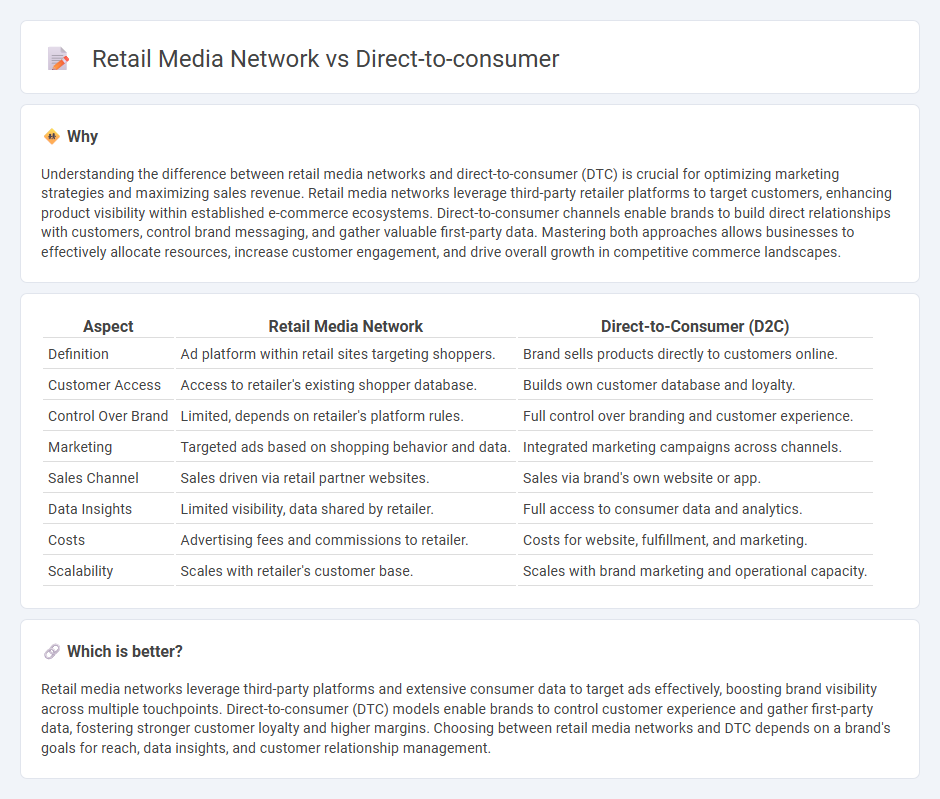
Retail media networks leverage data from retailers to deliver targeted advertising within e-commerce platforms, enhancing product visibility and consumer engagement. Direct-to-consumer (DTC) models allow brands to sell products directly to customers, bypassing traditional retail channels and fostering stronger consumer relationships and higher profit margins. Explore the differences and advantages of retail media networks versus direct-to-consumer strategies to optimize your commerce approach.
Why it is important
Understanding the difference between retail media networks and direct-to-consumer (DTC) is crucial for optimizing marketing strategies and maximizing sales revenue. Retail media networks leverage third-party retailer platforms to target customers, enhancing product visibility within established e-commerce ecosystems. Direct-to-consumer channels enable brands to build direct relationships with customers, control brand messaging, and gather valuable first-party data. Mastering both approaches allows businesses to effectively allocate resources, increase customer engagement, and drive overall growth in competitive commerce landscapes.
Comparison Table
| Aspect | Retail Media Network | Direct-to-Consumer (D2C) |
|---|---|---|
| Definition | Ad platform within retail sites targeting shoppers. | Brand sells products directly to customers online. |
| Customer Access | Access to retailer's existing shopper database. | Builds own customer database and loyalty. |
| Control Over Brand | Limited, depends on retailer's platform rules. | Full control over branding and customer experience. |
| Marketing | Targeted ads based on shopping behavior and data. | Integrated marketing campaigns across channels. |
| Sales Channel | Sales driven via retail partner websites. | Sales via brand's own website or app. |
| Data Insights | Limited visibility, data shared by retailer. | Full access to consumer data and analytics. |
| Costs | Advertising fees and commissions to retailer. | Costs for website, fulfillment, and marketing. |
| Scalability | Scales with retailer's customer base. | Scales with brand marketing and operational capacity. |
Which is better?
Retail media networks leverage third-party platforms and extensive consumer data to target ads effectively, boosting brand visibility across multiple touchpoints. Direct-to-consumer (DTC) models enable brands to control customer experience and gather first-party data, fostering stronger customer loyalty and higher margins. Choosing between retail media networks and DTC depends on a brand's goals for reach, data insights, and customer relationship management.
Connection
Retail media networks leverage first-party consumer data from direct-to-consumer (DTC) brands to deliver highly targeted advertising, enhancing customer engagement and boosting sales. DTC brands use retail media platforms to access valuable shopper insights and optimize their marketing strategies within the retail ecosystem. This symbiotic relationship drives revenue growth by combining precise audience targeting with streamlined product distribution.
Key Terms
Disintermediation
Direct-to-consumer (DTC) models eliminate intermediaries by enabling brands to sell products directly to customers, enhancing customer data collection and personalized marketing strategies. Retail media networks, meanwhile, leverage retailer-owned digital platforms to deliver targeted advertising within the shopping environment, maintaining a layer between brands and consumers but optimizing ad spend efficiency. Explore the advantages and challenges of disintermediation in DTC and retail media networks to understand their impact on modern marketing approaches.
First-party Data
Direct-to-consumer (DTC) brands leverage first-party data collected directly from customers through owned channels, enabling precise personalization, targeted marketing, and improved customer insights. Retail media networks utilize first-party data aggregated across retail platforms to deliver contextually relevant ads, enhancing marketing efficiency within commerce environments. Explore deeper into how first-party data shapes competitive advantages in DTC and retail media strategies.
Omnichannel
Direct-to-consumer (DTC) brands leverage personalized digital interactions to build direct relationships, while retail media networks harness retail platform data to target consumers across multiple channels. Combining DTC strategies with retail media networks enhances omnichannel marketing by integrating online and offline touchpoints for seamless customer experiences. Explore how these approaches revolutionize omnichannel engagement and drive sales growth.
Source and External Links
Direct-to-consumer - A business model where products are sold directly to customers, bypassing third-party retailers or wholesalers, often online but sometimes combined with physical retail spaces for a clicks-and-mortar approach.
What Is Direct-to-Consumer? Everything You Need To Know - Direct-to-consumer (DTC) brands sell products directly via their own website or digital channels, offering full control over fulfillment, marketing, and customer relationships, and often focusing on personalized customer experiences.
Direct to Consumer (DTC) Definition - Glossary - DTC is a sales strategy where manufacturers or consumer brands sell straight to consumers instead of through wholesalers or retailers, growing rapidly with ecommerce trends; some brands also combine online sales with physical stores but retain direct customer sales as primary.
 dowidth.com
dowidth.com